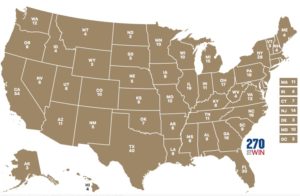The U.S. Constitution clearly specifies that the President by elected by the Electoral College. How exactly does this system work? Why was it originally put in place, and why in recent years has it been at the center of debates on election reform?
Introduction
View the Executive Summary for this brief.
The Electoral College is a process established by the Founding Fathers and included in the Constitution. Through this process, electors vote for President and Vice President. This system serves as a compromise between electing a president based on a Congressional vote and electing a president based on a popular vote. Where did the idea come from, and how does it work?
Why it Matters
The office of President of the United States is one of the most powerful positions in the world, given the U.S. role on the world stage. Ensuring the system that elects the president to office is fair and consistent is of the utmost importance to our democracy; it needs to respect the balance of power among the different branches of the federal government, among the states, and between the states and the federal government. Additionally, it is essential to our democracy that voters understand how the presidential election system works, and how their votes are counted.
History
Delegates at the Constitutional Convention in 1787 faced a difficult decision: how should the fledgling nation, comprised of 13 states of different sizes and differing opinions about states’ rights and the power of a central government, elect a president?
The ideas of a president chosen by Congress or state legislatures were rejected; either case presented the potential eroding of federal authority and an upset in the balance of power among branches of government. The option of election by direct popular vote was also rejected for fear that voters would likely not have enough access to information about all viable candidates and would only vote for candidates from their state or region.
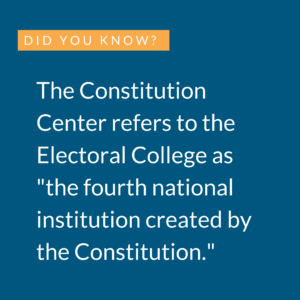 The idea of an indirect election that was aligned with the system of Congressional representation among the states was the best option to the Framers. This option was approved in September 1787 and incorporated in the Constitution. Article II, Section 1, Clauses 2 and 3 specify that the President be elected by the Electoral College. Each state appoints and has a specific number of Electors.
The idea of an indirect election that was aligned with the system of Congressional representation among the states was the best option to the Framers. This option was approved in September 1787 and incorporated in the Constitution. Article II, Section 1, Clauses 2 and 3 specify that the President be elected by the Electoral College. Each state appoints and has a specific number of Electors.
Originally, the Electoral College was meant to “govern the entirety of the process of selecting the president and vice president, from the initial function of identifying and winnowing the candidates to the final stage of electing these officers.” Today’s Electoral College comes into play at the end of the election cycle, with nominations performed by parties, state laws, and primaries.
Amendments
The Electoral College had been modified twice in our nation’s history. After electors cast an equal number of votes for Thomas Jefferson and Aaron Burr in the election of 1800, Congress ratified the 12th Amendment in 1803 to mandate electors cast at least one vote, and specify that vote as being for either president or vice president. In 1961, the 23rd Amendment allocated three electoral votes to the District of Columbia and authorized its treatment as a state in the Electoral College.
How it Works
Electors
The Electoral College is aligned with the system of Congressional representation. Since 1964, there have been 538 electors to match the total number of members of the U.S. House of Representatives (435) and the total number of U.S. Senators (100) plus three votes allocated to the District of Columbia. Each state has the same number of electors as it does members of Congress: one elector for each Representative in the House, plus two more votes for two Senators. A candidate must receive a majority (at least 270) of the 538 possible electoral votes to be elected president. 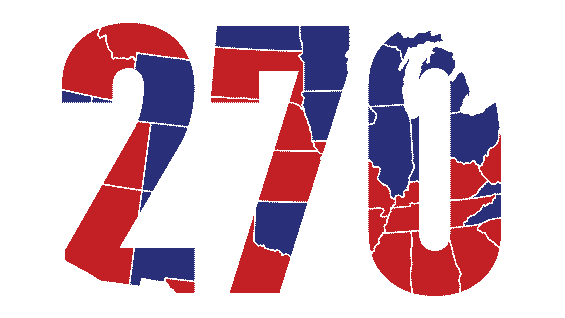
Who Can Be an Elector?
According to Article II, section 1, clause 2, no Senator, Representative, or person holding “an Office of Trust or Profit under the United States” can be an Elector. Essentially, this means anyone not holding an official federal office position is eligible. Other than that, there are few provisions relating to qualifications for Electors.
How are Electors Chosen?
Until the mid-1800s, state legislatures selected the electors. Today, electors are chosen through a popular vote in a two-step process. In the first step, actual electors are appointed according to rules set exclusively by the state legislatures. During the spring and summer before the general election, each party in each state nominates electors either at their state party conventions or by a central committee vote, depending on the rules of the state party. These individuals are usually state party leaders or consistent party members, or state or local elected officials that have some kind of “personal or political affiliation with their party’s presidential candidate.” By the end of this step, each presidential candidate has a set (called a slate) of potential electors. This means that each state has “several slates of electors, one for each recognized political party whose presidential and vice presidential candidates appear on the ballot.”
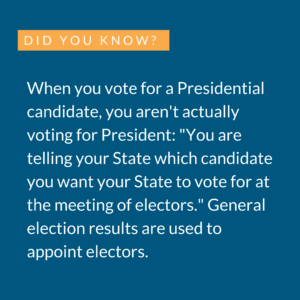 The second step happens during the general election in November when voters cast their votes for the presidential candidate. In reality, they are actually voting to select their state’s electors. In 48 states, the slate of electors associated with the winning candidate are appointed as the state’s electors in a winner-take-all system. Thus, if a majority of voters in a state vote for X Candidate, X Candidate’s slate of electors is elected. The process is slightly different in Nebraska and Maine, where the system is not winner-take-all. Instead, candidates receive one elector for each congressional district they win, and the state popular vote winner receives the final two electors. This method creates multiple popular vote contests that could lead to a split electoral vote. For example, in 2008 Barack Obama won one district in Nebraska and John McCain won the other two districts and the statewide vote.
The second step happens during the general election in November when voters cast their votes for the presidential candidate. In reality, they are actually voting to select their state’s electors. In 48 states, the slate of electors associated with the winning candidate are appointed as the state’s electors in a winner-take-all system. Thus, if a majority of voters in a state vote for X Candidate, X Candidate’s slate of electors is elected. The process is slightly different in Nebraska and Maine, where the system is not winner-take-all. Instead, candidates receive one elector for each congressional district they win, and the state popular vote winner receives the final two electors. This method creates multiple popular vote contests that could lead to a split electoral vote. For example, in 2008 Barack Obama won one district in Nebraska and John McCain won the other two districts and the statewide vote.
How do Electors Vote?
Potential electors vote like everyone else in the November general election, as they are not electors yet. They’re technically voting for themselves to be electors in the general election. After the votes have been tallied, each state has a meeting of the electors (usually the first Monday after the second Wednesday in December) and this is when the electors directly vote for the president and vice president. These ballots are sent to:
- The president of the U.S. Senate (the Vice President of the U.S.)
- The state’s secretary of state
- The National Archives and Records Administration
- The judge presiding over the district in which the electors meet
On January 6th following the election and meeting of electors, each state’s electoral votes are counted in a joint session of Congress. If no candidate receives at least 270 for a majority, the decision turns over to the House of Representatives. Each state delegation gets one vote to cast for president.
Nothing in the Constitution mandates electors vote according to the state’s popular vote results. Some states do require electors to do so or be subject to fines or be disqualified and replaced, and some parties may “extract pledges from electors to vote for the parties’ nominees.” For example, faithless electors in Michigan are treated as if they had resigned, and are replaced; Oklahoma imposes a civil penalty of a $1000 fine on faithless electors; and in New Mexico, a faithless vote is considered a felony. In the history of the electoral college, very few electors have disregarded the popular vote, and no elector has been prosecuted for being “faithless,” or failing to vote as pledged. However, several electors were replaced for failing to vote as pledged in 2016.
Relation to the Census
The results from the decennial Census, the population count of the United States, leads to the reapportionment of congressional districts across the country. Because the Electoral College is aligned with Congressional representation, there is a direct, one-to-one relationship between congressional representation and electoral votes. Therefore, when reapportionment leads to losses and gains in Congressional representation across the states, it means these states lose or gain electoral votes as well. The map above illustrates the electoral votes for 2024 and 2028. For more, see The Policy Circle’s Decennial Census Deep Dive.
Challenges and Areas for Reform
The Electoral College has been a key part of our country since its founding, but the debates surrounding the Electoral College have only grown more heated in recent decades.
Controversy
The Electoral College has on occasion produced controversial elections, the first of which can be dated back to 1800, when Thomas Jefferson and Aaron Burr, both on the Democratic-Republican ticket, received the same number of electoral votes. The decision went to the House of Representatives, which eventually elected Jefferson as President. This election also prompted the 12th Amendment, which mandates double balloting: the Electoral College now casts two separate votes, one for Vice President and one for President.
The next dilemma occurred in 1824, the first time the winner of the popular vote did not become the president. All four candidates (Andrew Jackson, John Quincy Adams, William H. Crawford, and Henry Clay) received Electoral votes, but no one received enough for a majority. Again, the House of Representatives made the final decision, which brought Quincy Adams to the White House despite Jackson having won the popular vote.
A similar phenomenon occurred in the 1876 election between Rutherford B. Hayes and Samuel Tilden. Tilden won the popular vote by over 3% but 20 Electoral votes were contested. A commission of 5 senators, 5 members of Congress, and 5 Supreme Court Justices awarded all 20 votes to Hayes.
Since, neither the House of Representatives nor an independent commission has been necessary; if nothing else, the Electoral College is decisive. Only a few elections have ended with the winner of the popular vote not winning the Electoral College. In 1888, Grover Cleveland won the popular vote but Benjamin Harrison won the Electoral College majority. In 2000, Al Gore won the popular vote by .5% but George W. Bush won the Electoral College by 5 votes. Again in the 2016 election, Hillary Clinton won the popular vote by 2.1% while Donald Trump won the Electoral College by 77 votes. Fair Vote dives deeper into these cases.
The Great Debate
As the Electoral College is a part of our Constitution, many respect it as a fundamental part of our country and believe it should not be changed. On the opposite end of the spectrum, many believe the winner of the national popular vote should always be the winner of the election. Although on the whole this has been a rare occurrence in our nation’s history, the fact that it has happened twice in the past two decades has brought the Electoral College to the forefront of election debates.
Supporters of the Electoral College assert it preserves “an important dimension of state-based federalism in our presidential elections,” presenting a good balance of federal and state powers. In fact, as written in the Constitution, the Electoral College allows states to conduct their elections without affecting other states. Additionally, it guarantees “our President will have nationwide support.” For example, supporters argue a national popular vote would give the most populous states the majority of the electoral power; candidates would focus on heavily populated cities, and give little attention to smaller, rural areas.
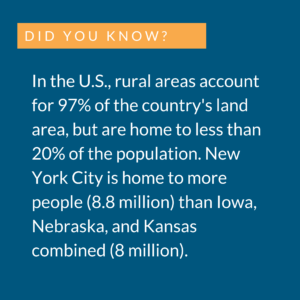 This is critical, because differences in geography relate to differences in issues that are important to people living in different areas. That all voices are heard, regardless of location, is essential for our democracy and ensuring the needs of all communities are accounted for.
This is critical, because differences in geography relate to differences in issues that are important to people living in different areas. That all voices are heard, regardless of location, is essential for our democracy and ensuring the needs of all communities are accounted for.
Similar to arguments against a national popular vote that would give too much power to largely populated states and regions, critics of the Electoral College argue the system reduces “the real field of play to fewer that a dozen ‘swing states’.” So-called swing states are states “with a significant number of electors that often switch between parties of different candidates.” Other arguments maintain the Electoral College is outdated. Part of the Founding Fathers’ concern with a national popular vote was that voters would simply choose candidates from their region because they would have the most information about those candidates. In today’s digital world, voters have much easier access to information about other candidates, and candidates have more access to voters across the country.
This video from TED-ex explains more:
Potential Reforms
Abolishment
The most extreme option of abolishing the Electoral College would require a Constitutional amendment. A Constitutional amendment requires support of two-thirds of both the House and the Senate, and three-fourths of the states.
State-based Reforms
Within the states there have been proposals to change the system given that the Constitution gives states control over how to award their electoral votes.
Many reform bills in the states have proposed switching from the winner-takes-all system of 48 states to the district system of Maine and Nebraska. The argument is that the winner-takes-all system is what gives too much power to the swing states; a candidate can amass a significant portion of electoral votes by focusing on a few key areas in these states. Additionally, former governor of Massachusetts William Weld and University of Texas Law School professor Sanford Levinson note that especially in close races, “[m]illions of votes for the losing party are systematically translated into zero representation” in a winner-takes-all system. Awarding electoral votes by district would possibly offer a more even distribution of votes. None of these proposals have ever passed in the states, but that doesn’t mean the debates surrounding the Electoral College have settled.
The National Popular Vote
In 2007, a movement for a National Popular Vote (NPV) gained traction in Maryland. According to the plan, the NPV would be “an interstate agreement for states to appoint their Electors for the winner of the national popular vote rather than the winner in each state.” For example, if X Candidate won the popular vote in California, but Y Candidate won the national popular vote, California would be required to send the electors of Y Candidate to its meeting of electors. As of mid-2021, 15 states (Delaware, Hawaii, Rhode Island, Vermont, Colorado, Connecticut, Maryland, Massachusetts, New Jersey, New Mexico, Oregon, Washington, California, Illinois, New York) and the District of Columbia, with a total of 195 electoral votes, have passed the bill into law. For now, this measure will not affect elections in those states; as it is written, the National Popular Vote bill will only go into effect when it is enacted into law by states possessing 270 electoral votes.
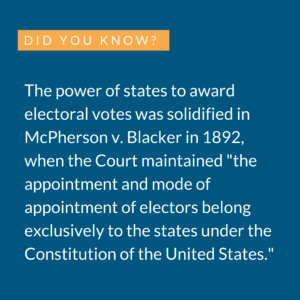 Critics argue the NPV would take away the state-based power of the Electoral College. Many believe the constitutionality of the NPV is also questionable. They argue that states do not have the power to enter such a compact without Congressional approval, but Congress cannot simply approve the NPV without a Constitutional amendment since the Electoral College is part of the Constitution. Attorney and author Tara Ross goes deeper into the purpose of the Electoral College, and why it is still relevant and should not be replaced in this episode of the She Thinks podcast from the Independent Women’s Forum.
Critics argue the NPV would take away the state-based power of the Electoral College. Many believe the constitutionality of the NPV is also questionable. They argue that states do not have the power to enter such a compact without Congressional approval, but Congress cannot simply approve the NPV without a Constitutional amendment since the Electoral College is part of the Constitution. Attorney and author Tara Ross goes deeper into the purpose of the Electoral College, and why it is still relevant and should not be replaced in this episode of the She Thinks podcast from the Independent Women’s Forum.
Those in favor of the NPV plan claim it would guarantee the Electoral College winner is the popular vote winner and that “every part of the Union would attract political investment and campaigning” rather than only a few key states with large amounts of electoral votes. Because the states have the constitutional power to form interstate compacts, they do not view the plan as unconstitutional, and additionally argue the “state-by-state winner-take-all method of awarding Electoral votes is nowhere to be found in the Constitution.”
For more on the math behind the Electoral College, see Why Do Math’s explanation.
Conclusion
In the “Federalist Papers,” Alexander Hamilton wrote that “the Constitution is designed to ensure ‘that the office of President will never fall to the lot of any man who is not in an eminent degree endowed with the requisite qualifications’.” The Founding Fathers tried to ensure this by incorporating the Electoral College into the Constitution, and it has held as a key part of our nation’s democracy for over two centuries. However, elections in recent years have made it possible for a candidate to win the popular vote but not the presidency. Finding the proper balance of voter, state, and federal power in elections is not an easy task, but it is one that our country will continue to debate to protect our democracy and ensure all voices are heard.
Ways to Get Involved/What You Can Do
Measure: Find out what your state and district are doing about the electoral college.
- Do you know how many electors your state has?
- Where does your state stand on the Electoral College or a National Popular Vote?
- How does your state handle “faithless voters“?
Identify: Who are the influencers in your state, county, or community? Learn about their priorities and consider how to contact them, including elected officials, attorneys general, law enforcement, boards of education, city councils, journalists, media outlets, community organizations, and local businesses.
- Who can be an elector in your state?
- What steps have your state’s or community’s elected and appointed officials taken?
Reach out: You are a catalyst. Finding a common cause is a great opportunity to develop relationships with people who may be outside of your immediate network. All it takes is a small team of two or three people to set a path for real improvement. The Policy Circle is your platform to convene with experts you want to hear from.
- Find allies in your community or in nearby towns and elsewhere in the state.
- Foster collaborative relationships with community organizations.
Plan: Set some milestones based on your state’s legislative calendar.
- Don’t hesitate to contact The Policy Circle team, communications@thepolicycircle.org, for connections to the broader network, advice, insights on how to build rapport with policy makers and establish yourself as a civic leader.
Execute: Give it your best shot. You can:
- Re-familiarize yourself with the constitutional background of the Electoral College, including the 12th and 23rd Amendments.
- Explore the distribution of electors across the country.
- Investigate the math behind the Electoral College with this interactive projection map.
- Find out if and how schools in your district explain the Electoral College as part of a government or civics class.
- See if there are opportunities with local organizations or district schools to engage with young and new voters on the subject. Consider volunteering or becoming a mentor.
Working with others, you may create something great for your community. Here are some tools to learn how to contact your representatives and write an op-ed.
Additional Resources
The Electoral College
- National Archives: The Electoral College
- 270 to Win Presidential Election Interactive Map
- National Council of State Legislatures: The Electoral College
- National Association of Secretaries of State: State Laws Regarding Presidential Electors
Voting
- 270 to Win provides election news for the Presidency, the Senate, the House, and elections at the state level.
- FiveThirtyEight (from ABC) tracks recent political news and polls.
- Bill of Rights Institute Think the Vote provides resources to help voters understand issues and elections, and engage in healthy civil discourse.
- Vote.org provides “everything you need to vote,” from information on election calendars and timetables to voter ID laws and absentee ballot rules.
